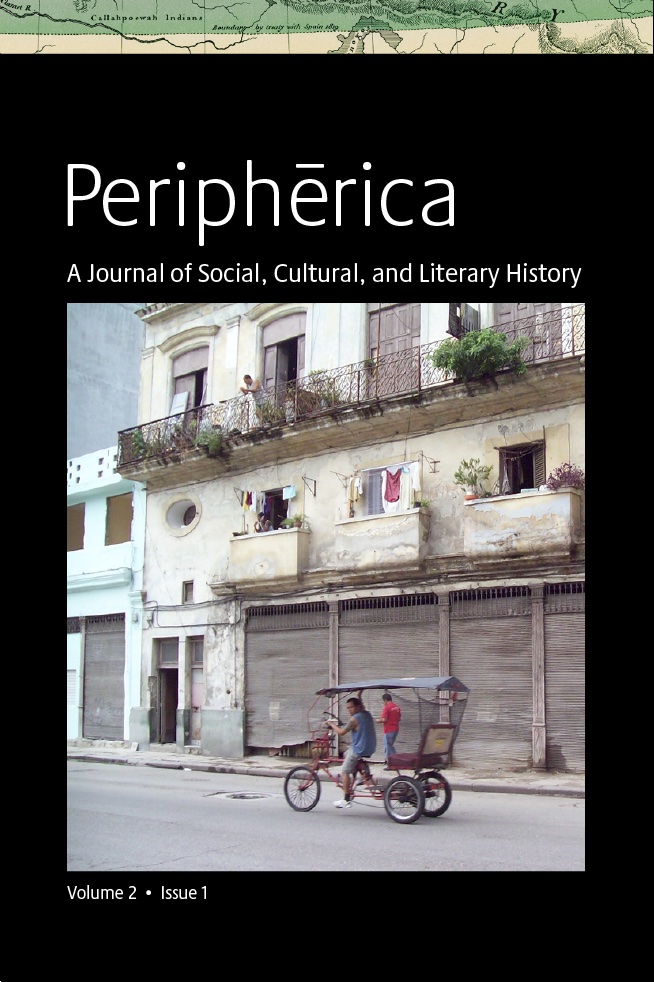Excedente español en la Cuba postsoviética: <i>Muerte de un murciano en La Habana</i> (2006)
DOI:
https://doi.org/10.5399/uo/peripherica.2.1.3Abstract
En este ensayo se analizan las estrategias visuales utilizadas en Muerte de un murciano en La Habana (2006), de Teresa Dovalpage, novela que interroga de forma paródica el impacto social de las dinámicas económicas en la Cuba postsoviética, a partir de una empresa escritural que apuesta por la intertextualidad y la auto-referencialidad. La escritora despliega una escritura postmoderna en la que se desplazan tanto sujetos como signos pictóricos españoles, parodiados en la misma operación traslaticia a un espacio local urbano: La Habana. Se propone que la autora se incluye a sí misma, como lo haría Velázquez en Las Meninas, no para arrojar luz sobre estrategias de representación, sino para llamar la atención sobre la figura del escritor emigrado en el mercado lingüístico regional, quien debe capturar la mirada de las editoriales transnacionales españolas, que ejercen su hegemonía en ese mercado.This essay analyzes the visual strategies used in Muerte de un murciano en La Habana (2006), by Teresa Dovalpage, a novel that parodically interrogates the social impact of economic dynamics in post-Soviet Cuba, based on a scriptural enterprise that uses intertextuality and self-referentiality. The writer deploys a series of postmodern strategies in which both subjects and Spanish Baroque pictorial signs are mobilized and parodied in the same operation as they are relocated onto a specific local urban space: Havana. I propose here that the author includes herself, as Velázquez would do in Las Meninas, not to shed light on representational strategies, but to draw attention to the figure of the migrant writer in a regional linguistic market, who must capture the gaze of Spanish transnational publishers, who exercise a hegemonic control in that market.
References
Aparicio, Frances y Susana Chávez-Silverman. Tropicalizations: Transcultural Representations of Latinidad. Dartmouth College Press, 1997.
Ayala, J. Ernesto. “En la nevera está el éxito”. El País, 23 diciembre 2006. Accedido 21 junio 2019.
https://elpais.com/diario/2006/12/23/babelia/1166835017_850215.html
Beltrán, Juan. “Un sentimiento llamado Cuba”. La Razón, 27 enero 2018. https://www.larazon.es/cultura/un-sentimiento-llamado-cuba-AH17543416. Accedido 14 noviembre, 2018.
Birkenmaier, Anke. “Más allá del realismo sucio: ‘El Rey de La Habana’ de Pedro Juan Gutiérrez”. Cuban Studies, vol. 32 (2001), pp. 37-54.
De Ferrari, Guillermina. “Cuba: A Curated Culture.” Community and Culture in Post-Soviet Cuba. Taylor & Francis, 2014.
Díaz Infante, Duanel. La revolución congelada: Dialécticas del castrismo. Editorial Verbum, 2014.
Dovalpage, Teresa. Muerte de un murciano en La Habana. Anagrama, 2006.
Feinberg, Richard E. The New Cuban Economy. What Roles for Foreign Investment? Latin American Initiative at Brookings, December 2012.
Fornet, Jorge. “Escritores y mercado editorial en Iberoamérica.” Revista Malabia, no. 49, 2017. http://www.revistamalabia.com/index.php/archivo/36-numero-49/45- escritores-y-mercado-editorial-en-iberoamerica.html.
Korek, Janusz. Central and Eastern Europe from a Postcolonial Perspective. Postcolonial Europe, 2009. http://www.postcolonial-europe.eu/essays/60--central-and-eastern-europe-from-a-postcolonial-perspective. Accedido 12 junio 2019.
Krull, Catherine. Cuba in a Global Context: International Relations, Internationalism, and Transnationalism. University Press of Florida, 2014.
Manzor, Lillian. Borges/Escher, Sarduy/Cobra Un Encuentro Posmoderno. Editorial Pliegos, 1996.
Owczarzak, Jill. “Introduction: Postcolonial studies and postsocialism in Eastern Europe.” Focaal, vol. 53, 2009, pp. 3-19.
Pérez Villanueva, Omar E. “La inversión extranjera directa en Cuba: necesidad de su relanzamiento”. Economía y Desarrollo, vol. 152, no.2 (jul.-dic.), 2014. http://scielo.sld.cu/scielo.php?script=sci_arttext&pid=S0252-85842014000200003.
Puñales Alpízar, Damaris. “La Habana de Antonio José Ponte y Pedro Juan Gutiérrez: el mapa de una ciudad marginal.” Mester vol. 41, no. 1, 2012, pp. 49-63.
Rojas, Rafael. The Fight over Fidel. Princeton University Press, 2015.
Serra, Ana. “Postcards from Abroad. The Cuban Special Period through Spanish Eyes.” Cuba in a Global Context: International Relations, Internationalism, and Transnationalism, editado por Catherine Krull, University Press of Florida, pp. 208-223.
Spivak, Gayatri Chakravorty, et al. “Are We Postcolonial? Post-Soviet Space.” PMLA, vol. 121, no. 3, 2006, pp. 828–836.
Sadowski Smith, Claudia. “A Homecoming without a Home.” Cuba: Idea of a Nation Displaced edited by Andrea O’Reilly Herrera, State University of New York Press, 2017, pp. 267-284.
Sarduy, Severo. Barroco. Editorial Sudamericana, 1974.
Valencia, Marelys. The Children of the Cuban Revolution in the Diaspora: From Internationalism to Transnational and Cosmopolitan Imaginaries. University of Miami, ProQuest Dissertations Publishing, 2017.
Yúdice, George. The Expediency of Culture Uses of Culture in the Global Era. Duke University Press Books, 2004.



